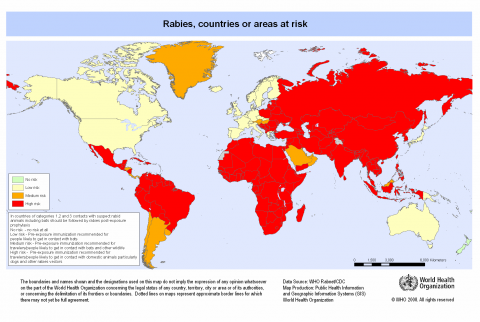-
Table of Contents
- 0. STORY PREFACE
- 1. RABIES - WHAT'S in a NAME?
- 2. RABIES in ANCIENT TIMES
- 3. WHAT IS RABIES?
- 4. LOUIS PASTEUR - EXPERIMENTER
- 5. LOUIS PASTEUR MEETS JOSEPH MEISTER
- 6. A TEEN HERO NAMED JEAN-BAPTISTE JUPILLE
- 7. LOUIS PASTEUR - WORLDWIDE BENEFACTOR
- 8. RABIES as a 21st-CENTURY PROBLEM
- 9. RABIES and ZOMBIES
The World Health Organization (WHO) provides a map depicting areas of the world where people are at risk from the rabies virus. Click on the image for a much-better view.
Although governments around the world advise pet owners to vaccinate their animals, not everyone does so.
Then there is the issue of wild animals who are infected with rabies. It’s not possible to immunize all of them.
As a result, the World Health Organization provides these facts:
- Rabies still exists in more than 150 countries and territories
- More than 55,000 people die of rabies every year (mostly in areas of Asia and Africa)
- 40% of the people who are bitten by rabid animals are children under the age of 15
- Dogs are the source of 99% of human rabies deaths
- Cleaning bite wounds and getting rabies shots within a few hours after being bitten by a rabid animal can prevent the onset of rabies and rabies-caused death
- More than 15 million people every year, around the world, receive shots after exposure to rabies
- Health-care experts believe these immunization treatments prevent around 327,000 rabies-related deaths, worldwide, every year
Some countries are rabies-free, but the United States is not one of them. Recent work, in America, has lead to another method of treatment ... this time for individuals who are already exhibiting symptoms of the rabies virus.
A person with symptoms cannot benefit from a rabies vaccination. Once the replicating virus reaches the victim’s brain, following its journey through the patient’s peripheral nervous system, nothing can be done to stop the symptoms.
If the patient has symptoms, there is nothing to vaccinate against. The point of a vaccination is to prevent the illness from occurring. Once it occurs, nothing can prevent a victim’s death.
That has been the case since Pasteur and his team developed their vaccine.

Then ... in 2004 ... an infectious-disease physician, in Milwaukee, faced a terrible problem. His patient, a teenage athlete, had symptomatic rabies. She would die unless something new could be tried to save her.
But what could be done? Since Pasteur’s vaccine began saving lives by preventing symptomatic rabies, scientists were no-longer studying the disease itself. Researches had turned their attention elsewhere, to other often-fatal illnesses.
Within a 24-hour period, Dr. Rodney Willoughby read everything about rabies which he could quickly gather; then he thought about what he could do to save his patient.
He and his team decided they would put her into a medically induced coma so her own immune system had time to develop much-needed antibodies. Those antibodies could then fight against the rabies virus.
Their main objective was to stop the virus from reaching the patient’s spinal chord and brain.
But would their theory work?
-
Table of Contents
- 0. STORY PREFACE
- 1. RABIES - WHAT'S in a NAME?
- 2. RABIES in ANCIENT TIMES
- 3. WHAT IS RABIES?
- 4. LOUIS PASTEUR - EXPERIMENTER
- 5. LOUIS PASTEUR MEETS JOSEPH MEISTER
- 6. A TEEN HERO NAMED JEAN-BAPTISTE JUPILLE
- 7. LOUIS PASTEUR - WORLDWIDE BENEFACTOR
- 8. RABIES as a 21st-CENTURY PROBLEM
- 9. RABIES and ZOMBIES
Media Credits
In-text graphic depicting the progression of the rabies virus in a human body is by Quizlet, copyright Quizlet, all rights reserved. Image provided here as fair use for educational purposes and to acquaint new users with the Quizlet Viral-Infection Flash Cards.


 Back
Back
 Next Chapter
Next Chapter

 Back
Back
 Next Chapter
Next Chapter
